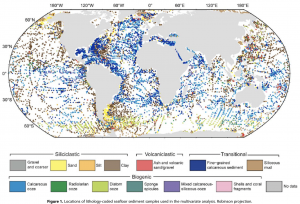Author List: Dr Adriana Dutkiewicz, Dr Simon O’Callaghan, Prof Dietmar Müller
Citation: Dutkiewicz, A., O’Callaghan, S., and Müller, R.D. (2016). Controls on the distribution of deep-sea sediments. Geochemistry, Geophysics, Geosystems 17 1–24. doi:10.1002/2016GC006428
Abstract:
Deep-sea sediments represent the largest geological deposit on Earth and provide a record of our planet’s response to conditions at the sea surface from where the bulk of material originates. We use a machine learning method to analyze how the distribution of 14,400 deep-sea sediment sample lithologies is connected to bathymetry and surface oceanographic parameters. Our probabilistic Gaussian process classifier shows that the geographic occurrence of five major lithologies in the world’s ocean can be predicted using just three parameters. Sea-surface salinity and temperature provide a major control for the growth and composition of plankton and specific ranges are also associated with the influx of non-aerosol terrigenous material into the ocean, while bathymetry is an important parameter for discriminating the occurrence of calcareous sediment, clay and coarse lithogenous sediment from each other. We find that calcareous and siliceous oozes are not linked to high surface productivity. Diatom and radiolarian oozes are associated with low salinities at the surface but with discrete ranges of temperatures reflecting the diversity of planktonic species in different climatic zones. Biosiliceous sediments cannot be used to infer paleodepth, but are good indicators of paleotemperature and paleosalinity. Our analysis provides a new framework for constraining paleosurface ocean environments from the geological record of deep-sea sediments. It shows that small shifts in salinity and temperature significantly affect the lithology of seafloor sediment. As deep-sea sediments represent the largest carbon sink on Earth these shifts need to be considered in the context of global ocean warming.

Controls on the distribution of deep-sea sediments
![]()
